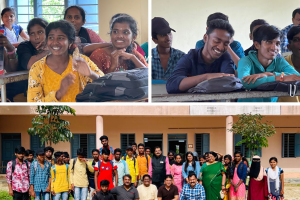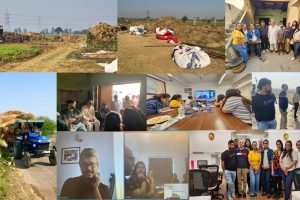An assessment of Indian media’s performance in highlighting wicked problems based on conversations with several journalists.
No journalist would dare to lock horns with the late chief minister J Jayalalithaa. She had a colourful record of “intimidating” reporters writing about corruption in her government. Her intimidation would either be in the form of defamation suits or something worse. She rarely granted interviews and never entertained tough questions. Ultimately, it was not the media but the intrepid Subramanian Swamy, who brought her jaw-dropping ‘disproportionate assets’ to light.
The media’s hands are often tied under such despotic state regimes. There is not much journalists can do here to tackle wicked or relentless problems such as corruption. Not much investigative reporting was done in her time – on her penchant for doling out freebies, for example. Bureaucrats – often good journalistic sources – were petrified of being quoted for fear of being summarily transferred.
To be fair, such behaviour was not limited to the ‘imperious lady’. In 2007, supporters of a former scion of the opposition DMK party burnt down a newspaper office, leading to the death of three people trapped inside. Probing a powerful TV family in Chennai also invites thinly veiled threats of physical harm. And then there are others who will only talk to amenable journalists.
It is not easy to be a journalist in India today. You are not just fighting oppressive state regimes but also a Big Brother watching over you from Delhi. Dwindling advertising revenues, the Internet, TV and social media have all taken their toll on print media houses.
Journalists are also a divided group. If they are not split by the medium (print is still the leader, TV is downright frivolous and online is largely upstarts, barring a few exceptions), then lines are drawn between nationalist vs. anti nationalist, us vs. them, English vs. regional, and more. In this scenario, is the media playing its part in solving wicked problems such as corruption, communal issues, and subjects related to environment and women’s safety? Yes and no.
Official figures reveal that 110,851 publications are registered in India, and nearly 900 channels are streamed through our television sets. These huge numbers unfortunately fail to reflect diversity of thought, asserts Paranjoy Guha Thakurta, Editor of Economic and Political Weekly.
He attributes this to a handful of media houses who dominate the market and form cartels with an unwavering eye on maximising profits. “The media is not imparting information and empowering citizens because they are regarded as potential consumers, not as citizens,” he says.
Apart from being hampered by crony capitalism, journalists also seem to have stopped asking the right questions. This, despite a lot of access to top bureaucrats, senior politicians and government officials.
Columnist and TV editor, Rajdeep Sardesai once said in an interview with the media watch website The Hoot: “Journalists have moved from asking questions to taking selfies. …We have become amoral beings who have become cheerleaders and who are completely carried away by what we see around us.” This might possibly be a bit harsh since it can be argued that media is just a mirror into society at large.
There is a consensus, however, that the mainstream Indian media has gone into a sedentary mode, when it comes to tackling the Big Cs – including corruption and communal issues – and doing major exposes. A story on the 2G scam, on corrupt deals at the Commonwealth Games, or on Coalgate, are few and far in between. However, there is ample space devoted to the dark deeds of Indrani Mukherjee and the exploits of Shahrukh Khan’s toddler AbRam.
“Where are the special investigative teams in newspaper offices spotlighting corruption stories? We are too caught up in routine, spot reporting and fail to do analysis of current issues,” says a senior political journalist.
Despite spy cams and tools like RTI, no corruption cases are uncovered on a regular basis, she points out. In 2009, TOI Chennai correspondents used spy cams to expose two medical colleges demanding capitation fees for admission to their MBBS course. But such investigative work is increasingly hard to come by.
Another veteran freelance journalist, Gunvanthi Balaram says: “Why were there not enough exposes on bank scams in India during demonetisation? The media has lost steam. We did several grassroots stories and hard-hitting reports on malnutrition, poverty and education during the 80s and 90s. There was lot of legwork involved; we would go miles to cover stories. Now, it is largely deskbound research and phone interviews”.
Journalists are criticised for currying favours and compromising their standing as unbiased observers. When the “Radia tapes” were uncovered, a very senior journalist from a leading national newspaper was ostensibly involved in lobbying the finance ministry for a favour. This news leaked after his message landed in another reporter’s WhatsApp group by mistake.
Media has also dropped its objectivity and become trapped in taking sides on issues. For example: are you against tying a human shield on a jeep to deter terrorists or not? Are you against lynching of Muslims or are you with the Army?
Some journalists feel major issues like corruption and climate change do not lend themselves to impactful coverage. “They require nuanced views. Media tends to over-simply and these subjects are not easily amenable for clever sound bytes,” says Thakurta.
Related coverage on television often lacks depth. “Corruption stories on TV and mass media seem to have the maximum impact today. The print media is struggling to survive and don’t have money to fund exclusives,” says another old-timer, Palakunnathu G Mathai, a former deputy features editor at The Telegraph.
The silver lining in this cloud involves small but sustained efforts by publications such as the Economic and Political Weekly; The Caravan and Indian Express; websites like Scroll.in, thewire.in, and indiaspend.com; and others funded by independent research foundations and philanthropic groups in different pockets of India. They boldly write stories on rising communalism in India, for instance, or expose the government and corporate nexus wherever this exists.
In some areas, the media does have a better score card. For example, it can pat itself on the back for steady coverage of problems involving the environment. Most newspapers and magazines feature environment or sustainability sections and consistently cover climate change, with stories ranging from studies on air quality to reports on salt water crocodile nests in a national park in Odisha.
Reportage of crimes against women is a mixed bag. Sometimes, a reporter’s ingrained chauvinism creeps in. Despite these stumbling blocks, after Nirbhaya, crimes against women regularly make it to a news editor’s story list.
What should the media do today to remain independent and operate in a climate free of fear to take on wicked problems? Thakurta has a solution: “Media groups have to look at alternative sources of funding such as foundations, crowd funding and charitable trusts to support independent writing. They need to tap these sources and get free of corporate pressures.”
No one can quibble over the media’s role as an ombudsman in battling the wicked problems of today. But with India’s economy and society in an ongoing churn, the media seems to be in a soporific state. It has to take cues from its past and emerge from this – to speak on behalf of citizens and to demand greater transparency in governance. An independent media is crucial for a strong and vibrant democracy and is a key part of the solution to many of our wicked problems.
Kavitha Shanmugam is a former journalist and Chief Content Curator at The PRactice.



